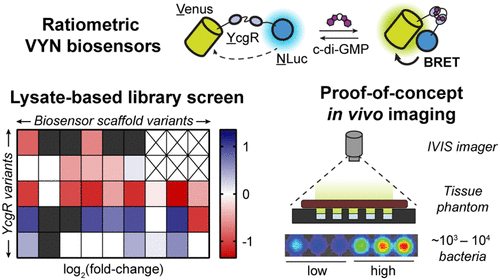当前位置:
X-MOL 学术
›
ACS Chem. Biol.
›
论文详情
Our official English website, www.x-mol.net, welcomes your
feedback! (Note: you will need to create a separate account there.)
Development of Ratiometric Bioluminescent Sensors for in Vivo Detection of Bacterial Signaling.
ACS Chemical Biology ( IF 3.5 ) Pub Date : 2020-03-25 , DOI: 10.1021/acschembio.9b00800 Andrew B Dippel 1, 2 , Wyatt A Anderson 1, 2 , Jin Hwan Park 3 , Fitnat H Yildiz 3 , Ming C Hammond 1, 2
ACS Chemical Biology ( IF 3.5 ) Pub Date : 2020-03-25 , DOI: 10.1021/acschembio.9b00800 Andrew B Dippel 1, 2 , Wyatt A Anderson 1, 2 , Jin Hwan Park 3 , Fitnat H Yildiz 3 , Ming C Hammond 1, 2
Affiliation

|
Second messenger signaling networks allow cells to sense and adapt to changing environmental conditions. In bacteria, the nearly ubiquitous second messenger molecule cyclic di-GMP coordinates diverse processes such as motility, biofilm formation, and virulence. In bacterial pathogens, these signaling networks allow the bacteria to survive changing environmental conditions that are experienced during infection of a mammalian host. While studies have examined the effects of cyclic di-GMP levels on virulence in these pathogens, it has not been possible to visualize cyclic di-GMP levels in real time during the stages of host infection. Toward this goal, we generate the first ratiometric, chemiluminescent biosensor scaffold that selectively responds to c-di-GMP. By engineering the biosensor scaffold, a suite of Venus-YcgR-NLuc (VYN) biosensors is generated that provide extremely high sensitivity (KD < 300 pM) and large changes in the bioluminescence resonance energy transfer (BRET) signal (up to 109%). As a proof-of-concept that VYN biosensors can image cyclic di-GMP in tissues, we show that the VYN biosensors function in the context of a tissue phantom model, with only ∼103-104 biosensor-expressing E. coli cells required for the measurement. Furthermore, we utilize the biosensor in vitro to assess changes in cyclic di-GMP in V. cholerae grown with different inputs found in the host environment. The VYN sensors developed here can serve as robust in vitro diagnostic tools for high throughput screening, as well as genetically encodable tools for monitoring the dynamics of c-di-GMP in live cells, and lay the groundwork for live cell imaging of c-di-GMP dynamics in bacteria within tissues and other complex environments.
中文翻译:

用于细菌信号体内检测的比例生物发光传感器的开发。
第二信使信令网络使细胞能够感知并适应不断变化的环境条件。在细菌中,几乎无处不在的第二信使分子环状双GMP协调着各种过程,例如运动性,生物膜形成和毒力。在细菌病原体中,这些信号网络使细菌能够在感染哺乳动物宿主期间经历的不断变化的环境条件中生存。虽然研究已经检查了循环中的di-GMP水平对这些病原体中毒力的影响,但在宿主感染阶段无法实时可视化循环中的di-GMP水平。为了实现这一目标,我们生成了第一个比例式化学发光生物传感器支架,该支架可选择性响应c-di-GMP。通过设计生物传感器支架,生成了一套Venus-YcgR-NLuc(VYN)生物传感器,可提供极高的灵敏度(KD <300 pM)和生物发光共振能量转移(BRET)信号的大变化(高达109%)。作为VYN生物传感器可以对组织中的循环di-GMP进行成像的概念证明,我们显示VYN生物传感器在组织模型模型的背景下起作用,仅需约103-104个表达生物传感器的大肠杆菌细胞即可。测量。此外,我们利用生物传感器在体外评估在宿主环境中发现的不同输入下生长的霍乱弧菌的循环双GMP变化。这里开发的VYN传感器可作为用于高通量筛选的强大的体外诊断工具,以及用于监测活细胞中c-di-GMP动态的可遗传编码的工具,
更新日期:2020-04-23
中文翻译:

用于细菌信号体内检测的比例生物发光传感器的开发。
第二信使信令网络使细胞能够感知并适应不断变化的环境条件。在细菌中,几乎无处不在的第二信使分子环状双GMP协调着各种过程,例如运动性,生物膜形成和毒力。在细菌病原体中,这些信号网络使细菌能够在感染哺乳动物宿主期间经历的不断变化的环境条件中生存。虽然研究已经检查了循环中的di-GMP水平对这些病原体中毒力的影响,但在宿主感染阶段无法实时可视化循环中的di-GMP水平。为了实现这一目标,我们生成了第一个比例式化学发光生物传感器支架,该支架可选择性响应c-di-GMP。通过设计生物传感器支架,生成了一套Venus-YcgR-NLuc(VYN)生物传感器,可提供极高的灵敏度(KD <300 pM)和生物发光共振能量转移(BRET)信号的大变化(高达109%)。作为VYN生物传感器可以对组织中的循环di-GMP进行成像的概念证明,我们显示VYN生物传感器在组织模型模型的背景下起作用,仅需约103-104个表达生物传感器的大肠杆菌细胞即可。测量。此外,我们利用生物传感器在体外评估在宿主环境中发现的不同输入下生长的霍乱弧菌的循环双GMP变化。这里开发的VYN传感器可作为用于高通量筛选的强大的体外诊断工具,以及用于监测活细胞中c-di-GMP动态的可遗传编码的工具,











































 京公网安备 11010802027423号
京公网安备 11010802027423号